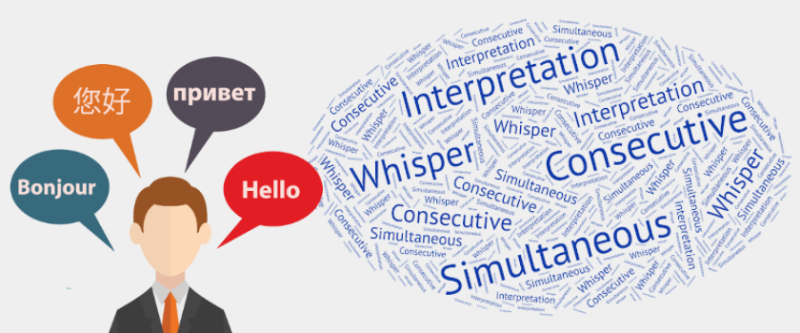For Events/Conferences/ Interpretation Services
- Ram Kesarwani - 9811 200 494
- ram@translationindia.com

SIMULTANEOUS INTERPRETATION EQUIPMENT
Interpretation services are indeed a boon to the business world as it makes communication in multiple languages a real-time reality. George Steiner had very well put the significance of interpretation. His famous maxim goes like this- “Without translation, we would be living in provinces bordering on silence”.
Now here’s a catch, my friend. Translation and Interpretation are often interchangeably used. I, myself, have stumbled on various pieces of text on the web that have completely turned a blind eye to the ever-glorious difference between the two. Let me make this blog the best of the bunch and elucidate the difference between Interpretation and Translation.
In George Steiner’s time, translation services were a fad. Translation focuses on written communication. Remember the English subtitles in Squid Game? Bingo! You guessed it correctly. That is what translation is all about. Unlike interpretation, translation is text-based.
Software, subtitles, multimedia, print, and videos are first converted into a basic file type and then translated into the desired language using computer-aided tools. Well, you might not want to go into the nuts and bolts of the tools used because this is not a live tech session. Let’s now catch a glimpse of translation’s significant other- Interpretation! Interpretation services handle verbal communication in real-time. Interpretation is indeed a much more daunting task as interpreters have to capture the tone and verbal dynamics of the speaker.
Do you get it now? You are probably here to know about the major types of interpretation. I have addressed your need below, my friend. Let’s scroll down without any further ado.
Let’s first get down to brass tacks. There are two major types of interpretation – Consecutive and Simultaneous interpretation. In consecutive interpretation, the speaker will deliver a few sentences and then pause for a jiffy to let the interpreter do its business. Now, let’s look at the other side of the spectrum. Simultaneous interpretation is done in real-time. The speakers use a microphone that relays the message to the interpreters.
They interpret it quickly in other languages. I don’t want to be in a squabble with the modern linguists because they suggest there are many more types. So, keeping world peace in mind, I have compiled a list of the 5 key types of interpretation. Have a look.
As the name suggests, whispered interpretation is the one in which the interpreter hears the message, interprets it, and whispers the interpretation to the client. Usually, every client has his personal interpreter for chuchotage. What’s that? It’s a ‘whispered interpretation’ in French.
I have been taking French classes lately. Imagine a conference with over a hundred delegates from different nations. Every delegate has his personal interpreter whispering into his ears. It would be hilarious. So, whispered interpretation is best suited for one on one meetings.
Relay interpretation is basically taking a detour. When there’s no interpreter available for a specific language like Vietnamese, then relay interpretation comes to the rescue. Let’s create a hypothetical scenario. Suppose, there are Turkish and Vietnamese delegates in a room. Unfortunately, the interpreter for Turkish to Vietnamese is not around. We, then, take a roundabout way and interpret Turkish to English and English to Vietnamese.
Escort interpreters become the travel buddies of the clients. They accompany the client to a previously agreed location and assist them with administrative tasks. So if a person is visiting Korea for a business trip, then the escort interpreter must be someone with sound cultural knowledge and an amiable personality.
Liaison interpretation is an imprecise mode of interpretation but what’s the harm as long as the business negotiations are successful? The aim of this type of interpretation is to bolster the relationships between the business partners rather than capture the essence of the languages spoken in the room. Usually, liaison interpretation is suited for small meetings with not more than four attendees.
Over-the-phone interpretation is a remote interpretation service. These services are available in more than a hundred languages. Can you think of its application? Yes, you are a genius. Usually, governments use OPI to convey a message nationwide. Remember the dreadful covid-19? During the pandemic, numerous messages regarding precautions and vaccines were being disseminated in different languages using OPI.
In this blog, I took you through 5 key types of interpretation services other than simultaneous and consecutive. There are many more types as well. With the technology evolving with each passing day, you might cross paths with a type of interpretation that will completely blow your mind. So, we will meet again at some point in the future with a few other types of interpretations. Till then, au revoir!
Consecutive interpretation is the most common type of interpretation. Here, the clients speak and then take a pause for the interpreters to relay the message.
It is simultaneous interpretation, hands down! In this type of interpretation, the magic happens in real-time. The speaker delivers the speech and the interpreters relay the message concomitantly.
Note: Get Simultaneous Interpretation Systems on Rental at Translation India
Interpretation is understanding a language and explaining it in another. The job of an interpreter includes listening to the client’s words in say, Spanish and translating them into English for others to comprehend.
Imagine yourself attending a French seminar. You have no clue what the speaker is trying to convey, do you? Interpretation services are monumental in making communication effective by breaking down language barriers.
First and foremost, the interpreter should be honest and ethical. You might not want someone who is manipulative and fiddles with the original message. The interpreter must also be focused and not easily distracted by mild noise. Furthermore, an ideal one will have a demonstrated history of accomplishments in language interpretation and expertise in capturing non-verbal cues.
To learn more about Translation India, visit www.translationindia.com, or you can call us at 9811200494 or email us at ram@translationindia.com for further information.